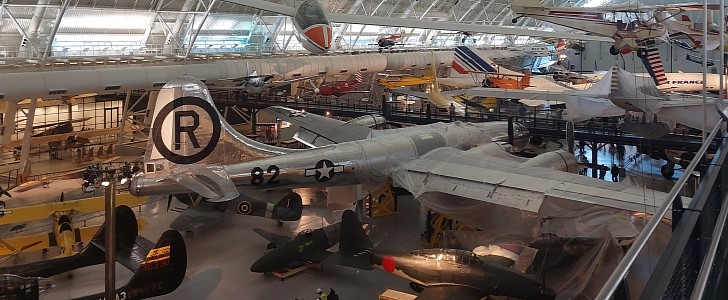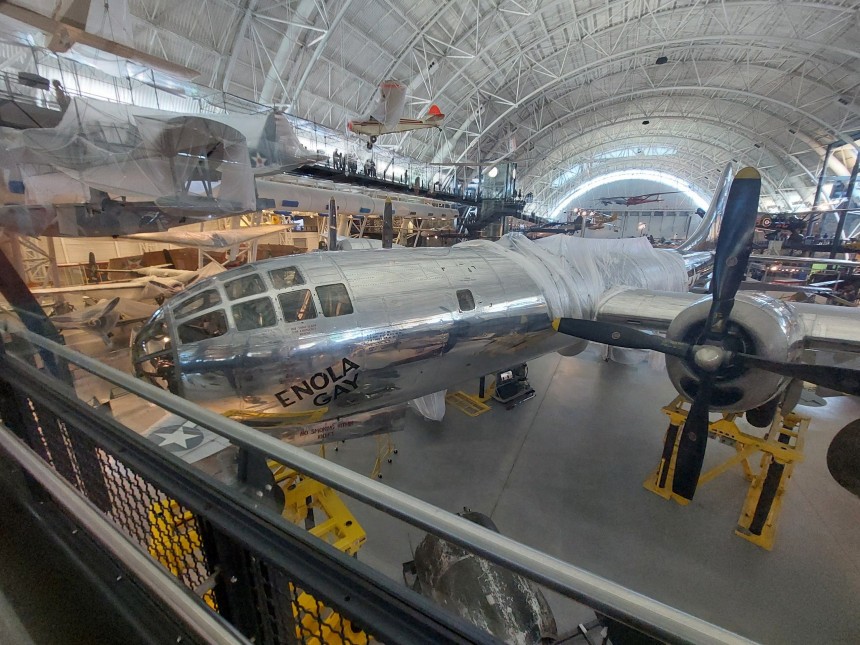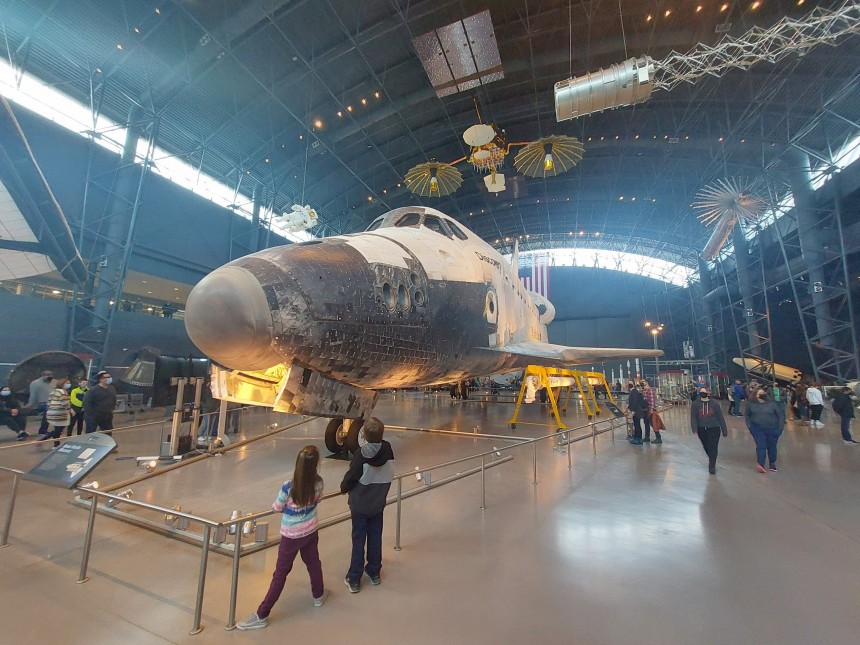So far on Spotlight USA, we've been to military aircraft museums that are positively tiny, utterly enormous, and now, something in-between. The Steven F. Udvar-Hazy Center in Chantilly, Virginia, is somewhere in the Goldilox zone of the spectrum.
Opened in 2003, the Steven F. Udvar-Hazy Center is an official Annex of the Smithsonian Air and Space Museum in Washington D.C. It sits adjacent to Dulles International Airport, which handles most air traffic headed in or out of the D.C. Metro Area. It's the perfect alternative to the main D.C. museum for people who'd rather not deal with the chaos of the nation's capital.
So then, if the Udvar-Hazy Center is simply an annex of the larger museum in D.C., why bother making the 30 and a bit mile trip to Virginia? Well, there's a handful of aircraft on display that you won't find in D.C. Or anywhere else on the planet, for that matter. Come and join us as we give you the highlights.
The Steven F. Udvar-Hazy museum is named in honor of the Hungarian-American businessman and founder of the Air Lease Corporation. "Hazy," as he's often called, escaped communist-controlled Hungary in the late 1950s and would go on to lead a fabulously successful airliner leasing firm. The billionaire gifted a donation of over $60 million to construct this official annex of the National Air & Space Museum. Today the facility sees hundreds of thousands of visitors per year.
Where do we even begin to start? Probably at the beginning, we imagine. The museum's impressive collection of very early aircraft would be the envy of any museum. Icons like the Sopwith Camel, Spad XVI, and Curtis Jenny all find themselves under the same room in remarkable like-new condition. It's not the most extensive collection around, but it might be the prettiest.
Elsewhere, bits and pieces of every era of aviation are proudly on display. It's perfectly typical to see a couple of P-51 Mustangs, P-47 Thunderbolts, or P-38 Lightnings hanging around the World War Two section of an American museum. But nowhere else in North America is the other side of the War in Europe so amazingly documented. Everything from Fokke-Wolf Fw-190 F-8, the bonkers twin-engined Dornier Do-335 Arrow, and the innovative Arado Ar-34 Blitz jet bomber proudly have a home in the Udvar-Hazy Center across the aisle from the very planes they were built to shoot down.
Imperial Japan is also very well represented. The Nakajima Kikka jet fighter flew only a handful of times before the end of the war. Now, Japan's first jet can be marveled upon by every museum visitor. So too can the sole surviving Kyushu J7W Shinden prototype, a fighter that appears to have been assembled backward.
The museum's collection spans mankind's ambitions of flight from the earliest lighter than air balloons to the latest VTOL prototype fighters and reusable space vehicles. All are represented with exhibits like a woodcut prepared artwork of the first American manned balloon flight in 1793, all the way to the X-35 VTOL prototype fighter. But the museum's real star attraction is Space Shuttle Discovery.
The museum previously hosted Shuttle Enterprise, the non-space-faring test vehicle. Enterprise was transferred to the USS Intrepid Air & Space Museum in New York City when Discovery was decommissioned in March 2011. The museum's spaceflight exhibits are largely formed around the main Space Shuttle attraction. Missiles, rockets, and even the Space Lab mobile laboratory flew on the Shuttle, display prominently surrounding the Shuttle. The exhibit houses many items on display that have flown in space on American, European, or Russian missions.
The museum's aircraft restoration hangar is up the stairs and adjacent to the Spaceflight exhibit. If classic car restoration documentaries are totally your thing, this part of the museum is a dream come true. Across the hall from the restoration hangar sits the second-biggest attraction of the museum. The pristinely preserved Enola Gay, the B-29 Superfortress that dropped the "Little Boy" nuclear weapon over the Japanese city of Hiroshima in August 1945.
You can peer right into the cockpit from the elevated platform above the museum's bottom floor. One can almost envision the crew's faces in their mind's eye. The look of abject horror and awe as the world was plunged headfirst into the atomic age. For the more helicopter inclined folks, the museum has a section dedicated to the wackiest verticle lift experiments ever to fly, including an experimental U.S. Navy chopper with Ram-jets in the rips of its rotors.
This only scratches the surface of what's on display. We'll be delving even deeper to fish out what we thought were the most fabulous airplanes on display throughout the coming week. It just goes to prove it's not always about pure size when it comes to aerospace museums. Sometimes, it's about jamming as many fantastic items into a limited amount of space as physically possible. Many thanks to the PR team and museum staff of of the Steven F. Udvar-Hazily Center for allowing us to bring you another fascinating edition of Spotlight USA. Your hard work is appreciated and not un-recognized. Check back for more from our trip right here on autoevolution, and thank you for reading.
So then, if the Udvar-Hazy Center is simply an annex of the larger museum in D.C., why bother making the 30 and a bit mile trip to Virginia? Well, there's a handful of aircraft on display that you won't find in D.C. Or anywhere else on the planet, for that matter. Come and join us as we give you the highlights.
The Steven F. Udvar-Hazy museum is named in honor of the Hungarian-American businessman and founder of the Air Lease Corporation. "Hazy," as he's often called, escaped communist-controlled Hungary in the late 1950s and would go on to lead a fabulously successful airliner leasing firm. The billionaire gifted a donation of over $60 million to construct this official annex of the National Air & Space Museum. Today the facility sees hundreds of thousands of visitors per year.
Where do we even begin to start? Probably at the beginning, we imagine. The museum's impressive collection of very early aircraft would be the envy of any museum. Icons like the Sopwith Camel, Spad XVI, and Curtis Jenny all find themselves under the same room in remarkable like-new condition. It's not the most extensive collection around, but it might be the prettiest.
Imperial Japan is also very well represented. The Nakajima Kikka jet fighter flew only a handful of times before the end of the war. Now, Japan's first jet can be marveled upon by every museum visitor. So too can the sole surviving Kyushu J7W Shinden prototype, a fighter that appears to have been assembled backward.
The museum's collection spans mankind's ambitions of flight from the earliest lighter than air balloons to the latest VTOL prototype fighters and reusable space vehicles. All are represented with exhibits like a woodcut prepared artwork of the first American manned balloon flight in 1793, all the way to the X-35 VTOL prototype fighter. But the museum's real star attraction is Space Shuttle Discovery.
The museum previously hosted Shuttle Enterprise, the non-space-faring test vehicle. Enterprise was transferred to the USS Intrepid Air & Space Museum in New York City when Discovery was decommissioned in March 2011. The museum's spaceflight exhibits are largely formed around the main Space Shuttle attraction. Missiles, rockets, and even the Space Lab mobile laboratory flew on the Shuttle, display prominently surrounding the Shuttle. The exhibit houses many items on display that have flown in space on American, European, or Russian missions.
You can peer right into the cockpit from the elevated platform above the museum's bottom floor. One can almost envision the crew's faces in their mind's eye. The look of abject horror and awe as the world was plunged headfirst into the atomic age. For the more helicopter inclined folks, the museum has a section dedicated to the wackiest verticle lift experiments ever to fly, including an experimental U.S. Navy chopper with Ram-jets in the rips of its rotors.
This only scratches the surface of what's on display. We'll be delving even deeper to fish out what we thought were the most fabulous airplanes on display throughout the coming week. It just goes to prove it's not always about pure size when it comes to aerospace museums. Sometimes, it's about jamming as many fantastic items into a limited amount of space as physically possible. Many thanks to the PR team and museum staff of of the Steven F. Udvar-Hazily Center for allowing us to bring you another fascinating edition of Spotlight USA. Your hard work is appreciated and not un-recognized. Check back for more from our trip right here on autoevolution, and thank you for reading.









































